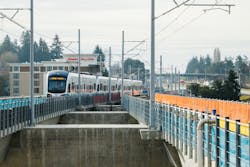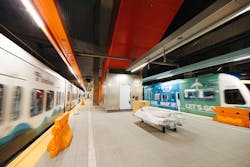Expanding light-rail transit in Seattle
After 15 years of planning, design, and construction, Sound Transit’s Northgate Link extension will open on Oct 2, 2021.
The 4.3-mile extension connects to Sound Transit’s existing 20-mile light-rail system, extending it northward from the current terminus at the University of Washington Stadium. The first 3.5 miles of the extension are underground, and the final 0.8 miles, ending at Northgate station, are elevated.
The underground station in the University District is conveniently located near the University of Washington campus, home to nearly 50,000 students. The underground Roosevelt Station connects to a vibrant neighborhood and nearby Green Lake. The elevated station at Northgate is close to the headquarters of the Kraken, Seattle’s new NHL team, and its three NHL regulation skating rinks, which are expected to attract 800,000 visitors a year. The station will also provide easy access via a pedestrian bridge to North Seattle College.
Planning for the extension began in 2006. Voters approved the Northgate Link extension in 2008 as part of the Sound Transit 2 ballot measure. Construction on the project began in 2012 following six years of planning.
One of the project’s major accomplishments are the twin tunnels for the underground portion of the extension. Tunneling began in 2014 and finished in 2016.
Facing challenging ground and water conditions, along with urban construction constraints, Sound Transit and Northgate Link tunneling contractor JCM (a joint venture of Jay-Dee Contractors, Coluccio, and Michels) clocked more than 2 million staff hours, successfully completing two parallel tunnels on budget and on time. Using two tunnel boring machines—weighing 600 tons each—JCM excavated more than 500,000 cubic yd of soil, yet kept community impacts to a minimum.
Crews hand dug 23 cross passages that connect the two parallel tunnels. Building a cross passage every 1,000 ft along the alignment ensures that riders will never be further than 500 ft from a cross passage, a bit more than a city block.
Some of the most interesting and complex work are the roughly 7,400 ft of tracks beneath the University of Washington. The rails in this part of the tunnel will rest on a “floating slab," a series of extra-dense concrete slabs that each weigh 11,000 lb. Each of the 1,618 slabs will sit on custom-built rubber pads sourced in part for their durability and vibration-absorbing properties.
Sound Transit took a special approach in this section of tunnel because the tracks run underneath the University of Washington main campus near 26 buildings where research is conducted with extremely precise equipment like electron microscopes. This equipment, and the billions of dollars in research conducted at UW, are very sensitive to vibrations and electromagnetic interference that can come from operating electric trains 20 hours a day. The floating slab will absorb the vibrations and other potential interference at the source.
Guideway construction was completed in 2018 and rail installation in 2019. Construction of all three stations was substantially complete at the beginning of 2021, and starting last January, light-rail test trains have been operating across the alignment to test the system.
The project’s $1.9 billion baseline budget includes a $615 million credit agreement under the Transportation Infrastructure Finance and Innovation Act (TIFIA), which provided significant long-term savings for regional taxpayers through reduced borrowing costs. The final project cost is expected to come in under budget.
With the opening of the Northgate Link extension, passengers will be able to avoid one of the region’s most congested stretches of I-5, into downtown Seattle. The trip from the Northgate Station to the University District Station will take only seven minutes and to downtown Seattle only 14 minutes. The ride to Sea-Tac Airport station from the Northgate Station will take just 47 minutes. During peak hours, trains will run every eight minutes. Average daily ridership on the extension is estimated to be between 41,000 and 49,000 by 2022.
“The opening of Link to Northgate is very well timed with our region’s long-awaited shift back toward normal life,” said Sound Transit CEO Peter Rogoff. “Our region has been through a brutal year, and we are thrilled to give our riders and taxpayers the opportunity to celebrate a major expansion of transit options. This project has been able to advance during a pandemic through the extraordinary efforts of our project staff, construction workforce, and our contractors. Great care needed to be taken to protect the health of every worker and their families while achieving each project milestone. “
The opening of the Northgate Link extension will coincide with significant service changes for ST Express, King County Metro Transit, and Community Transit bus routes. In some cases, bus routes will be modified to allow riders to connect with congestion-free Link service instead of traveling all the way into downtown Seattle.
With Northgate’s completion, Sound Transit will enter a period of opening major light-rail extensions every year through 2024, nearly tripling the region’s light-rail system from 22 miles to 62 miles. The Lynnwood Link extension will extend 8.5 miles from the Northgate station to Lynnwood City Center, adding four new stations to the light-rail system. Other projects currently under construction will extend service to Tacoma’s Hilltop in 2022, East King County in 2023, and Federal Way in 2024.


